Changes in Terrain
In which I unintentionally write a travelogue about southern Lazio

Cari amici,
Heading north from Campania, you’re approaching the small town of Fumone in Lazio. Off the A1, you wind around Ferentino, following the instructions of your Google Maps navigator (you’ve named him Francesco) and doubting his judgment nearly every step of the way. “This can’t be right,” you mutter as the roads narrow and twist through descending fog, and narrow and twist, and twist and climb, eventually becoming a series of switchbacks that summit at the Fumone city walls. In this part of Lazio, hill towns abound. You hadn’t realized what a topographical map could have shown you: the province of Frosinone, off the main thoroughfare, is ruggedly mountainous, and Fumone sits atop a steep, pointy summit.
The “you” in the previous paragraph was me, of course, on a five-day road trip to visit my cousins in Campania, meet up with friends in Fumone, and explore southern Lazio. What’s stuck with me since my return is how varied the terrain was among the places I visited (all within about an hour and a half of one another) despite all of it being mountainous. From what I saw on my meandering travels, Italy’s geographic personality changes as quickly as its dialects do.
Fumone is a sweet little walled town with a castle that draws crowds in the warmer seasons. Roughly circular, its cobblestoned streets wind around the castle and dip down to the city walls. The views in any direction are superb: fog-laced valleys, snow-capped mountains, forests and hamlets and groves, and the sense of time suspended.
“Sweet” probably isn’t the right word for Fumone, though—the town’s history is tightly aligned with that of the Catholic Church and its defenses. For more than 500 years Fumone served as a lookout point for threats approaching from the south. Its name means “big/large/great smoke,” referring to the warning signals sent up and passed along by other towns to the Vatican, 93 kilometers northwest.
The castle also served as a prison for the Church’s political enemies, which included, apparently, one of its own. In 1294 the Church imprisoned Papa Celestino V (Pope Celestine V) at Fumone Castle after he resigned from the papacy. An ascetic hermit in his 80s when he was elected pope, he’d accepted the role reluctantly, only because the Church was desperate; the papacy had been vacant for two years. Seven months later Celestino resigned, reasoning that it would be dangerous for the Church if he remained pope because he was more interested in pursuing his ascetic values than helming the Church, and besides, he didn’t trust the Cardinals. The Cardinals considered his resignation unlawful and put him under supervision; eventually he was imprisoned at Fumone by the pope who succeeded him, Boniface VIII.
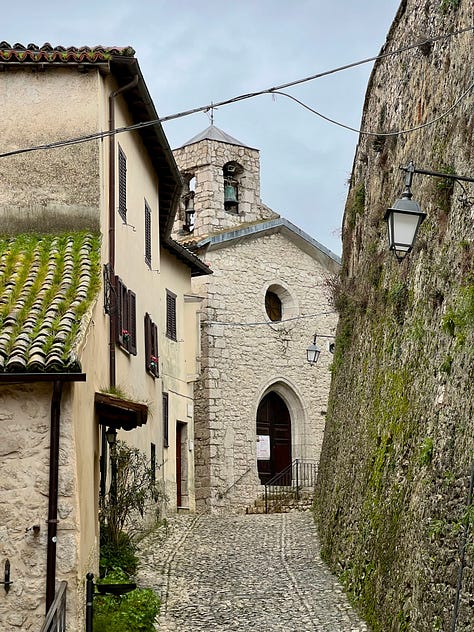
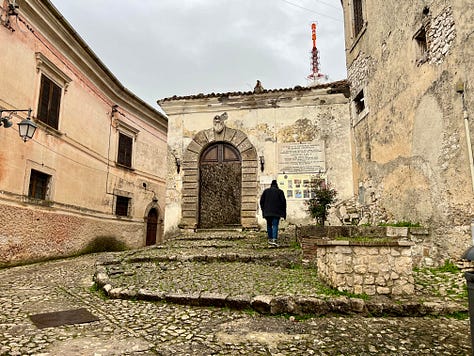
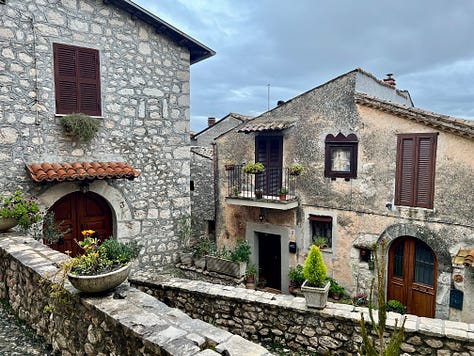
The castle is said to be haunted, and one of its ghosts supposedly belongs to the wax-encased body of a murdered child that has lain there for centuries (actually, since the fifth century). The child, the last born to the Longhi family, was the only son—and thus the heir, a fact that his seven sisters didn’t like at all. So they poisoned him. Ah, families!
Sorry, no photos of the boy or his ghost; the castle was closed. But hey, I can show you this place instead, for sale for less than €100k!
From Fumone I meandered east, skirting the commercial sprawl of Frosinone and heading toward Sora on a two-lane regional highway where games of chicken, at least that day, were all the rage, forcing me to brake as drivers intent on passing a string of vehicles raced their cars straight toward me. So much fun!
Past Sora, I veered north to Alvito, then on to San Donato Val di Comino, a town of about 2,000 set in a spectacular mountainous region at the edge of the Parco Nazionale d’Abruzzo, Lazio, e Molise. It’s almost certainly the birthplace of my bisnonna (great-grandmother) Angela Mazzola. I’d hoped to gain access to the parish archives on this trip, to find the missing genealogical puzzle pieces I need; unfortunately, radio silence from the powers-that-be at the Curia Vescovile di Sora meant the best I could do was explore the town. (I’ve been stalking the place virtually for months, and let me tell you, whoever does the town’s Instagram account is on it.)

It took nanoseconds for me to fall in love. The town is charming and well kept, with an ancient historic center, lots of pedestrian-only streets, and hill climbs that are nothing compared to Perugia’s. I found the street my bisnonna was born on (if the Angela Mazzola I found in online documents is in fact her), which is, and probably was then, the low-rent district. Walking the circuitous street (actually a sidewalk) uphill, I imagined my ancestors’ house there—two rooms max, I’ll bet, likely a kitchen and a bedroom, and both small and dark. My bisnonna left her hometown and spent most of her life in Sonnino, and I wonder why. Was it to marry her first husband, or her second? Or did she make the long trek across the Val di Comino, past Frosinone and over the Monti Ausoni to Sonnino as a child, with her parents?

As I typically find in my travels in Italy, people are friendly and eager to help. In San Donato Val di Comino I chatted with several men on the street who said that if my bisnonna’s surname was Mazzola, she was surely sandonatese. Another kind gent connected me with someone at the local museum, Museo del Novecento e della Shoah, who might help me find my bisnonna’s documents; asked someone else to open the town’s most important church for me (Santuario di San Donato); pointed out a few apartments for sale; and gave me his real-estate–agent daughter’s business card. (Yes, I went to her office for a chat.) The museum guy took time away from the school group he was guiding to chat for a few minutes; we’ll be in touch via WhatsApp.
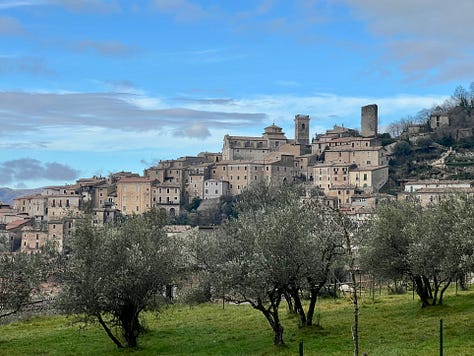

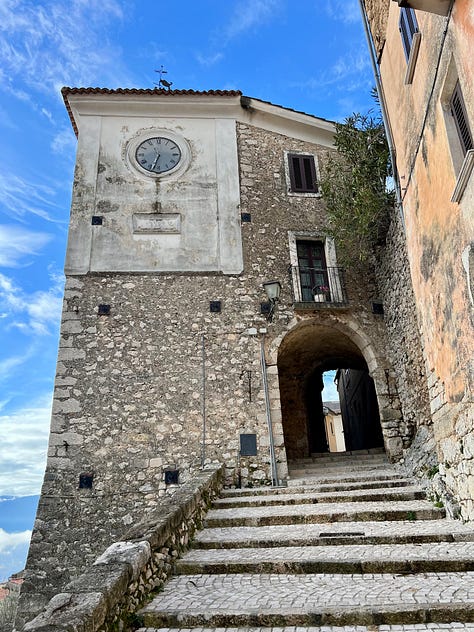
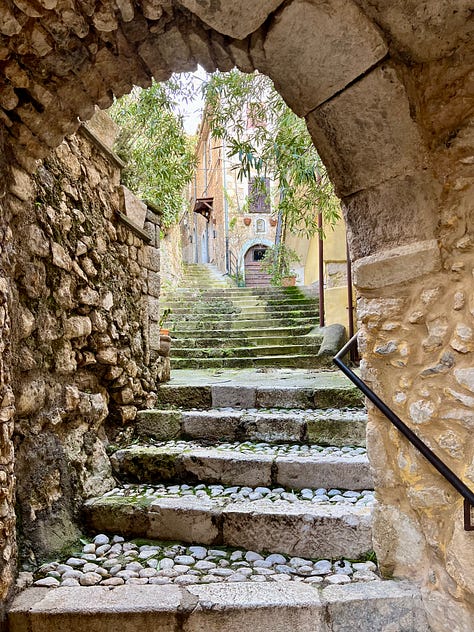


I’d planned to have lunch in San Donato Val di Comino but found nothing open except a pasticceria and a bar, so I hit the road, headed toward Sonnino, in the province of Latina. Along the way I stopped at one of those ubiquitous gas-stations-with-a-bar, thinking I’d pick up a sandwich. Instead, I was soon enjoying a delicious lunch of tagliatelle with pecorino cheese sauce and crumbled sausage. Fats? Calories? I’ve heard they don’t count when you’re on the road.
Back to the topic of terrain (digressions, digressions!)—well, talk about contrasts! While the land around Fumone is a series of pointy peaks bristling with castles and walled hill towns, all defensive and severe, the verdant plain of Val di Comino slopes gently upward to meet the towering Appennines. And the coastal area of Latina? It’s rugged and rocky, seemingly determined to deter any efforts to scrabble out a living from the land. Every countryside house has a perimeter wall built from local stones, which burst from the earth like furious eruptions on a teenager’s skin. And the stones are everywhere. These lands can host olive trees and vineyards, but little else.
After a stop in Fossanova to see the Cistercian abbey there, built between 1163 and 1208—it’s vast and devoid of ornamentation except for nature-based details on columns and pilasters, as was the Cistercian way—I drove to Sonnino. My goal was a return visit to the cemetery to see if I’d overlooked the graves of Angela and her second husband, my bisnonno. (The grave of one of their daughters is still there, but I have so far failed to find five other family members.) Mid-search, what had been a tolerable rainstorm became a deluge. Within minutes steps had become waterfalls and what feeble daylight there was quickly descended into dusk, cutting short my visit. Next time! Coming down from the mountain on narrow roads with blind corners and no turnouts, I prayed for minimal oncoming traffic and, as usual, cursed Francesco for his choice of percorso (route).
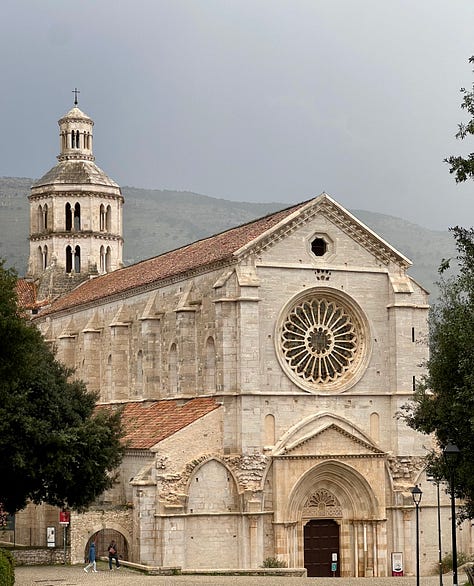


I ended my basso Lazio (southern Lazio) giretto (little tour) with a quick visit to Terracina, not to see the city itself but to walk along the shore. After the harsh terrain around Sonnino, I wanted to feel the generosity and expansiveness of the ocean.
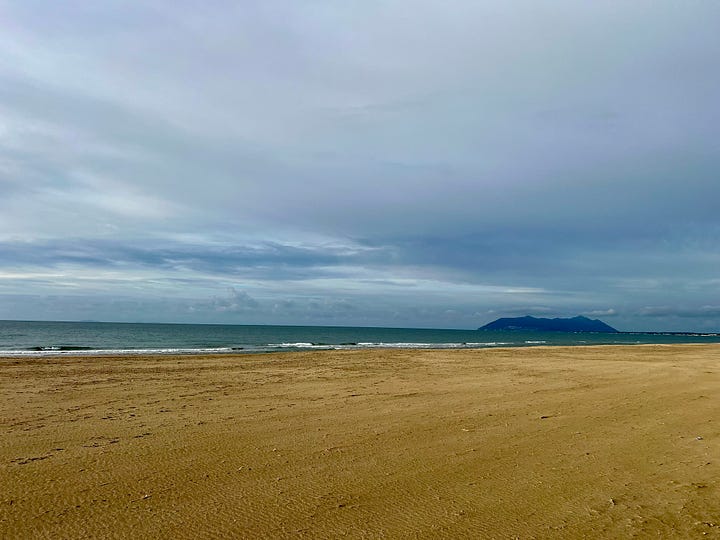
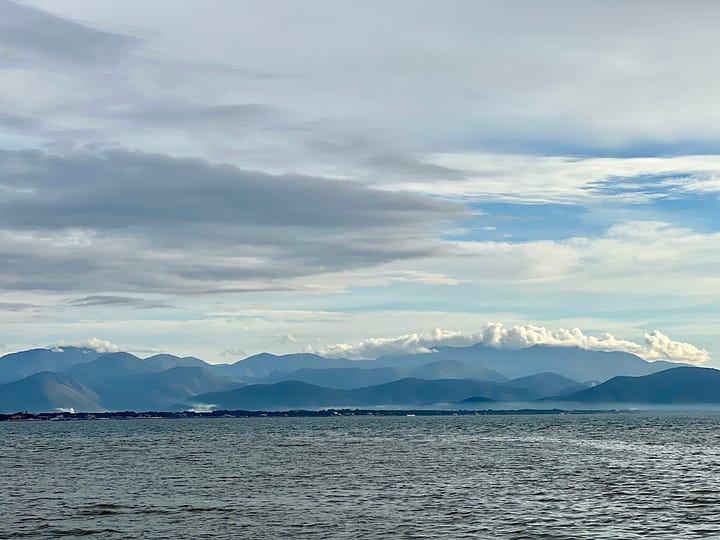
Terracina’s harbor and historic center cower beneath the vertical cliff of Monte Sant’Angelo, topped by the ruins of the Temple of Jupiter Anxur. What remains of the temple is a columned terrace built in the opus incertum technique (Roman), in which uncut, irregularly shaped stones were set in a type of concrete. Halfway down the cliff, ruined structures are visible, but Google provides no clues to what they are. I should have asked a local. Next time!
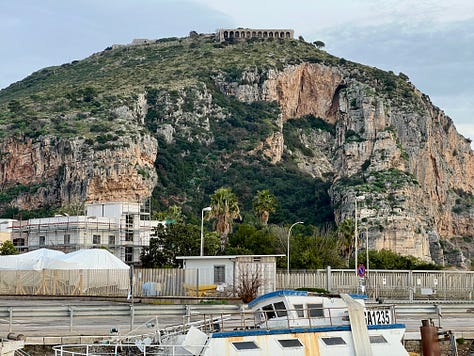
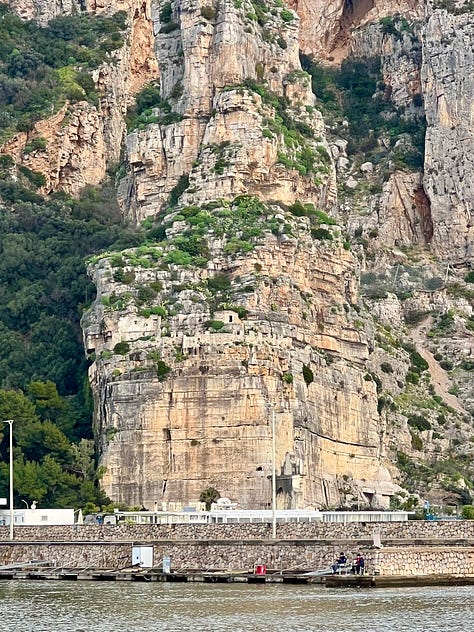
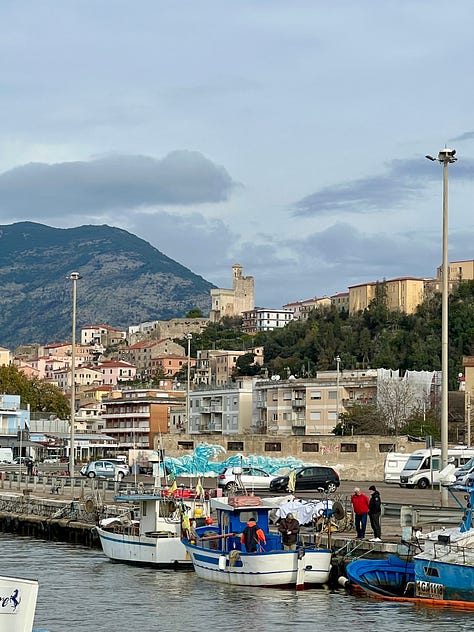
Tante belle cose, alla prossima—
Cheryl
Italian language notes of the day
Before my basso Lazio jaunt I visited my cousins in Campania, and though I’ve been there several times before, my language experience this time was different.
First, as is typical of the south, they use the passato remoto often, even for recent events that would normally take the passato prossimo. For some reason I hadn’t noticed that before, which may mean that my ear is getting more fine-tuned. Which leads me to observation number 2: dialect.
During previous visits, I must have either let dialect slide right by without trying to understand it, or I else didn’t realize it was dialect at all, just Italian I didn’t understand. This time, at lunch with my cousins, I’d overhear exchanges that didn’t include me and though they weren’t complete gibberish, I wasn’t sure what I was hearing. I asked my cousin Elisabetta whether it was dialect, or a mix of Italian and dialect, or Italian with some dialect sounds mixed in (lots of sh and ch sounds), and it turns out it was straight-up dialect. Interesting that though I’m light years away from any real knowledge of the dialect, I’m not hearing it as a completely foreign thing anymore.
Moral of the story: keep plugging away. Sometimes progress can be measured in ways you don’t expect.
Book of the day
I’m currently reading Italy in Mind, a collection of stories, essays, poems, and letters about traveling in Italy, edited by Alice Leccese Powers. Included are works by Henry James, Gore Vidal, Edith Wharton, Susan Sontag, D.H. Lawrence, Ernest Hemingway, and Elizabeth Barrett Browning, to name a few. I’m really enjoying the variety of subject matter and form.
P.S. My book! Which you can buy here or on the usual sites, or, better yet, order it from your local bookstore. Another fab option is to ask your library to stock it. If you read it and like it, please tell your friends and/or leave a few lines of praise on any bookish site. You’d be surprised how much a rating or review helps authors. Baci!


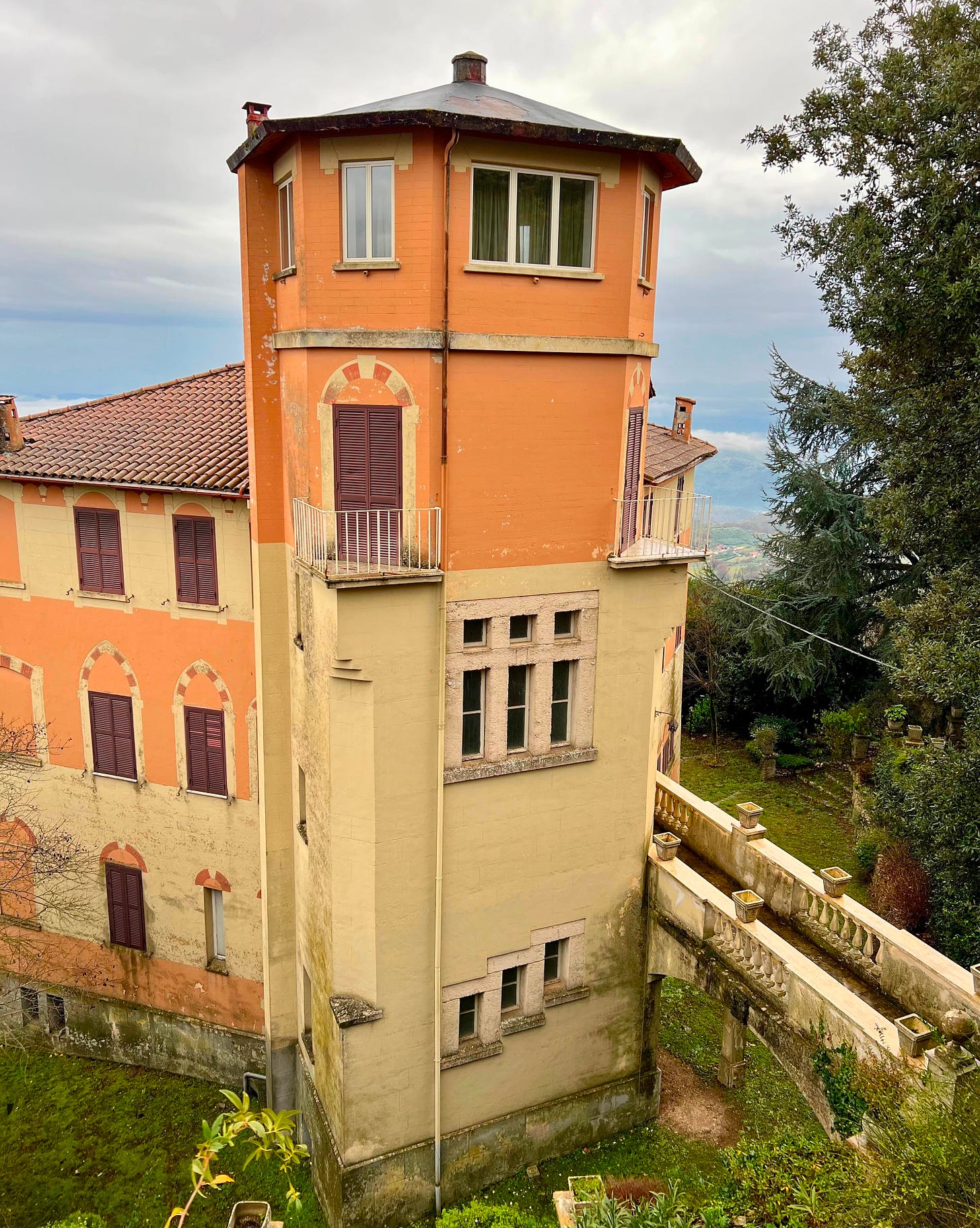


Thank you for taking us to southern Lazio with you.
Curious about your book—is it a novel? Or what genre? And the collection you noted—when was it published? Thanks for sharing your travel story. ❤️